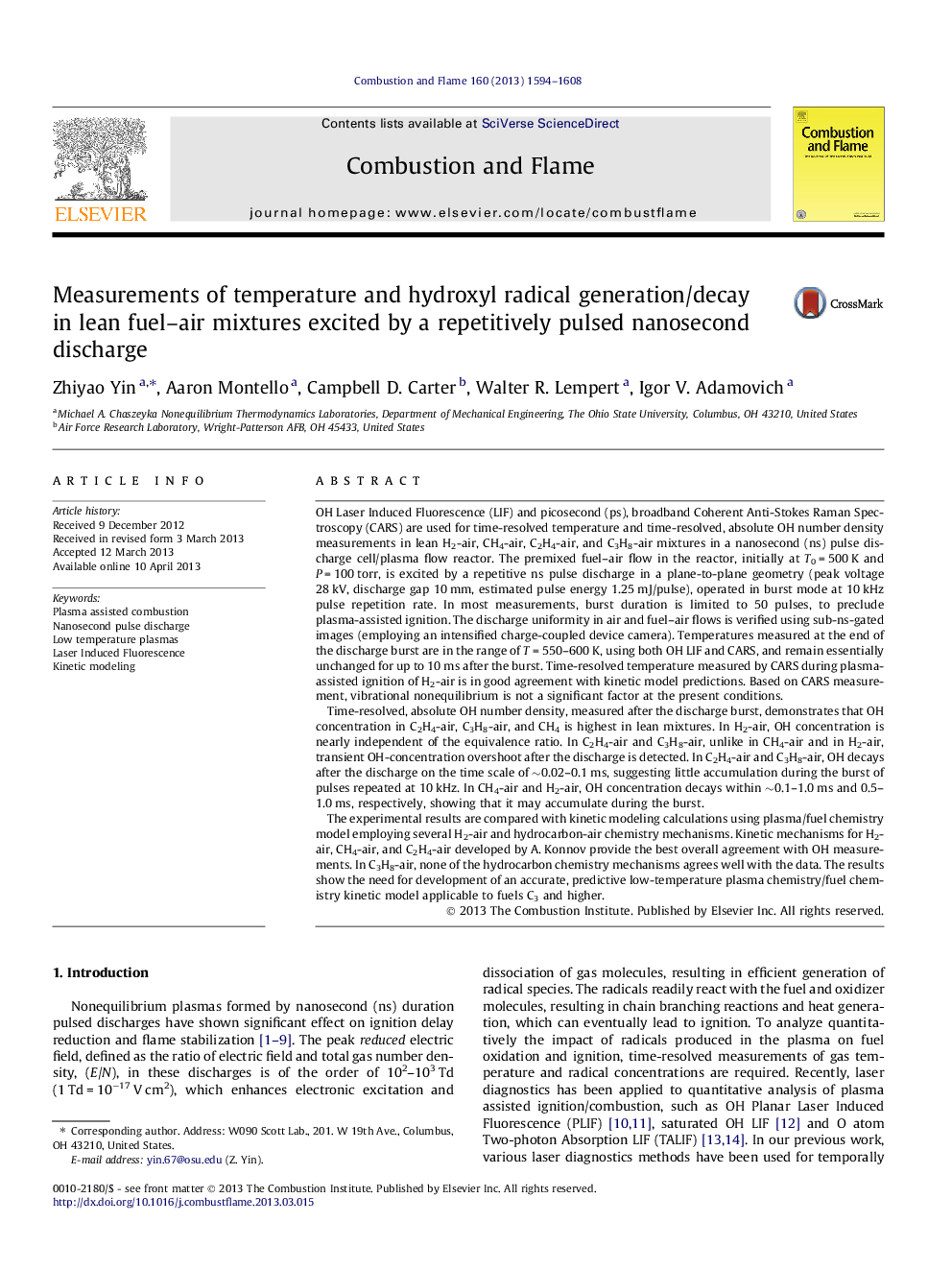| کد مقاله | کد نشریه | سال انتشار | مقاله انگلیسی | نسخه تمام متن |
|---|---|---|---|---|
| 166935 | 457829 | 2013 | 15 صفحه PDF | دانلود رایگان |

OH Laser Induced Fluorescence (LIF) and picosecond (ps), broadband Coherent Anti-Stokes Raman Spectroscopy (CARS) are used for time-resolved temperature and time-resolved, absolute OH number density measurements in lean H2-air, CH4-air, C2H4-air, and C3H8-air mixtures in a nanosecond (ns) pulse discharge cell/plasma flow reactor. The premixed fuel–air flow in the reactor, initially at T0 = 500 K and P = 100 torr, is excited by a repetitive ns pulse discharge in a plane-to-plane geometry (peak voltage 28 kV, discharge gap 10 mm, estimated pulse energy 1.25 mJ/pulse), operated in burst mode at 10 kHz pulse repetition rate. In most measurements, burst duration is limited to 50 pulses, to preclude plasma-assisted ignition. The discharge uniformity in air and fuel–air flows is verified using sub-ns-gated images (employing an intensified charge-coupled device camera). Temperatures measured at the end of the discharge burst are in the range of T = 550–600 K, using both OH LIF and CARS, and remain essentially unchanged for up to 10 ms after the burst. Time-resolved temperature measured by CARS during plasma-assisted ignition of H2-air is in good agreement with kinetic model predictions. Based on CARS measurement, vibrational nonequilibrium is not a significant factor at the present conditions.Time-resolved, absolute OH number density, measured after the discharge burst, demonstrates that OH concentration in C2H4-air, C3H8-air, and CH4 is highest in lean mixtures. In H2-air, OH concentration is nearly independent of the equivalence ratio. In C2H4-air and C3H8-air, unlike in CH4-air and in H2-air, transient OH-concentration overshoot after the discharge is detected. In C2H4-air and C3H8-air, OH decays after the discharge on the time scale of ∼0.02–0.1 ms, suggesting little accumulation during the burst of pulses repeated at 10 kHz. In CH4-air and H2-air, OH concentration decays within ∼0.1–1.0 ms and 0.5–1.0 ms, respectively, showing that it may accumulate during the burst.The experimental results are compared with kinetic modeling calculations using plasma/fuel chemistry model employing several H2-air and hydrocarbon-air chemistry mechanisms. Kinetic mechanisms for H2-air, CH4-air, and C2H4-air developed by A. Konnov provide the best overall agreement with OH measurements. In C3H8-air, none of the hydrocarbon chemistry mechanisms agrees well with the data. The results show the need for development of an accurate, predictive low-temperature plasma chemistry/fuel chemistry kinetic model applicable to fuels C3 and higher.
Journal: Combustion and Flame - Volume 160, Issue 9, September 2013, Pages 1594–1608